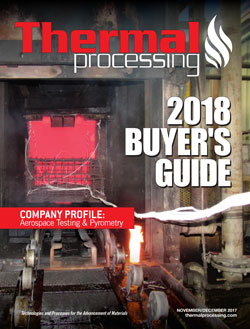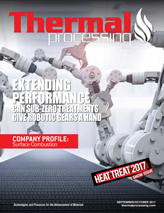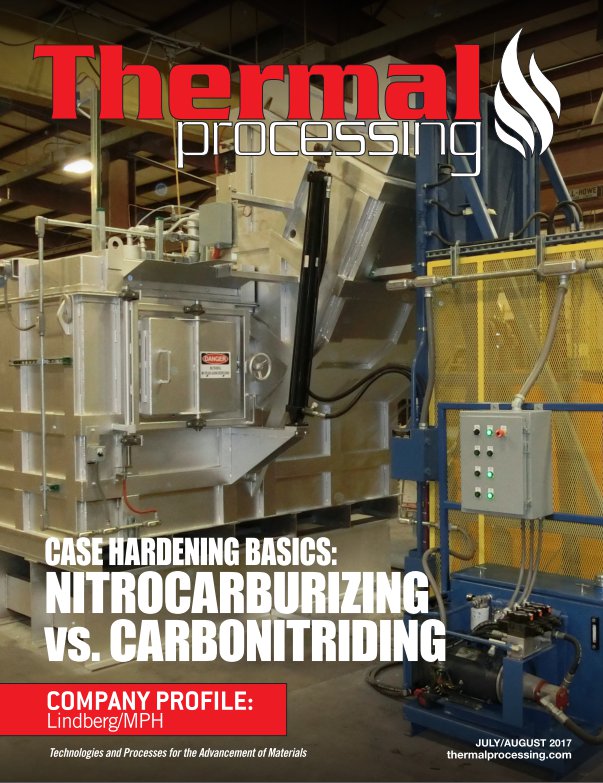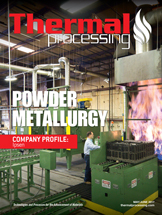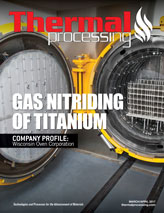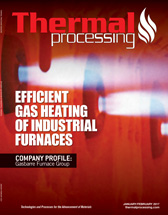Archives
November 2017
Aerospace Testing & Pyrometry
With its motto, “Profit from our knowledge because quality is our standard,” Aerospace Testing & Pyrometry keeps a laser focus on aerospace pyrometry compliance and a top priority on the customers it serves.
September 2017
Case Study: Cost effective, low distortion carburizing of internal helical ring gear for transmissions
There are many critical factors that are assessed when designing a gear that will be used in demanding applications such as engines or transmissions. Design engineers typically assess gear material, availability, cost, formability, machineability, and heat-treat ability for the specific application. They also evaluate the materials’ anticipated loads and the materials’ mechanical properties, such as […]
Extending Performance
Metal gears and precision components of all types are in growing demand for robotics, particularly in industrial sectors such as automotive, aerospace, and machinery. Innovative gear designs make possible industrial and service robots capable of virtually any desired motion. Sequences can be programmed for specific operations, from welding and assembly, to even delicate tasks such […]
Single-piece flow case hardening can be worked into in-line manufacturing
Case hardening by carburizing is the most common heat treatment in mass production, which relies on atmosphere or vacuum carburizing followed by oil or gas quenching and finally by tempering. Parts being heat-treated undergo the process in a configuration of a batch that consists of hundreds or thousands of pieces. It’s obvious a particular part […]
July 2017
Case Hardening Basics: Nitrocarburizing vs. Carbonitriding
Confusion surrounding the case-hardening techniques of nitrocarburizing and carbonitriding prove the point that it’s easy to get lost in the nomenclature behind heat-treating processes. That comes with the territory. Metallurgy is complicated. But there’s value to explaining the differences between these techniques1 and the benefits that result from their uses, including cutting down on the […]
Case Study: Conrad Kacsik and Modern Industries
Modern Industries, one of the largest heat-treating facilities in Pennsylvania, has seen its share of equipment come and go since its beginning 71 years ago. According to Bryan Jageman at Modern Industries, it’s not the furnaces themselves that have changed that much, but the technology of the controllers that control the furnaces — the ability […]
Company Profile: Lindberg/MPH
Lindberg/MPH has been around for over 100 years. During that century, it has changed hands and names, but since it became part of Thermal Product Solutions (TPS), the company has been making great strides to alter its entire culture. And with that cultural change, Lindberg/MPH has become one of the more profitable and fastest-growing brands […]
May 2017
Hardening of Powder Metallurgy Parts 101
Powder metallurgy (PM) is unique in that one has the ability to create a process system (alloy, process steps, and secondary operations) specific to the requirements of a given application. The following is a brief overview of the key terminology associated with the hardening of PM parts. Definitions Particle Hardness Versus Apparent Hardness Any hardened […]
Vacuum Diffusion Pumps
Vacuum diffusion pumps come in a variety of sizes and are capable of producing high vacuum in a range from 10-2 to 10-10 torr. It’s a simple operational principle that makes it desirable for many industrial applications including electron-beam microscopy, vacuum deposition, coatings, and vacuum furnaces. The durability and reliability of a diffusion pump is […]
Induction Heat Treating: How to Shorten the Time to Production
In an increasingly competitive world, it is good to pause and ask: How can we do our work faster, better, and use fewer resources? Induction Tooling Inc. has disrupted the traditional approach to validating selective hardening inductors, getting them into production faster than ever before and with improved production results. The vision allows testing and […]
Ensuring Effective Furnace Lining Efficiency
Refractory engineers remain under constant pressure to increase the performance of furnaces, incinerators, and reactors to maximize energy efficiency. Although there are many materials that can enhance the efficiency of furnaces, many still lose heat when in operation through flue gas, excess moisture in fuel, or continued opening of the furnace door. This is preventing […]
Elemental Analysis of Metal Powders and Metal Parts Produced by Additive Manufacturing
An integral part of industrial product development is the manufacture of prototypes and initial samples, regardless of whether the product is a simple screw or the complex part of an airplane. To fabricate single, and oftentimes small, pieces in a production environment is usually a costly procedure. Based on this cost-benefit calculation, a special application […]
March 2017
Computerized Design of Straight Bevel Gears with Optimized Profiles for Forging, Molding, or 3D Printing
Straight-tooth bevel gears are the simplest type of bevel gears that can be used for power transmission between intersecting shafts. They are commonly referred to as straight bevel gears, for brevity. Shafts for power transmission with straight bevel gears are usually mounted at a shaft angle of 90 degrees but can be designed to work […]
Gas Nitriding of Titanium
Interest in solution gas nitriding and diffusion of nitrogen into the surface of titanium alloys as a means to inhibit adhesive wear (galling) while replacing heavier steel machinery parts has been increasing in applications involving moving components. The use of vacuum furnaces with partial-pressure nitrogen atmospheres provides a practical and economical means for titanium nitride […]
Infrared Temperature Measurement Theory and Application
An infrared thermometer measures temperature by detecting the infrared energy emitted by all materials at temperatures above absolute zero, (zero degrees Kelvin). The most basic design consists of a lens to focus the infrared (IR) energy onto a detector, which converts the energy to an electrical signal that can be displayed in units of temperature […]
Effects of the Composition of Ca-Rich Inclusions on Tool Wear Mechanisms During the Hard-Turning of Steels for Transmission Components
This study describes the influence of the steel characteristics of Ca-treated carburizing steel grades during hard part turning of synchronizing rings in gearbox production. The main focus was on the chemical composition of the non-metallic inclusions in the evaluated workpieces and their effect on the PCBN tool wear. In addition, a Ca-treated carburizing steel grade […]
January 2017
Case Study: Busch LLC and Vakuum-Harterei Petter GmbH
Vakuum-Härterei Petter GmbH (VHP) based in Quickborn, Germany, is a contract hardening facility that specializes in high-quality heat treatment under vacuum. The company has a total of nine vacuum ovens. The materials handled are mainly high-alloy steels, but non-ferrous metals are also heat-treated. The core activities of VHP are hardening, annealing, brazing, soldering, and tempering. […]
Understanding the Cooling Curve Test
When a hot component comes in contact with the liquid quenchant, there are normally three stages of quenching. There are exceptions to this, which will be explained in each stage. The three stages of quenching are: Vapor stage (stage A or vapor blanket stage) Boiling stage (stage B or nucleate boiling stage) Convection stage (stage […]
Buying a New Lab or Industrial Furnace
When the time comes to purchase a new lab or industrial furnace, there are several points that need to be considered before going out for bids. One of the first considerations should be the desired operating temperature that will be used most often. “Most often” because many new lab and industrial furnace purchasers often assume […]
Efficient Gas Heating of Industrial Furnaces
There are various types of high-efficiency gas burners and radiant tubes currently on the market, and economic tools can be used to assess investments in heating technology for industrial furnaces. In addition, a revolutionary combustion technology now makes it possible to have the best of both worlds — increased efficiency and suppressed NOx emissions. Gas […]










